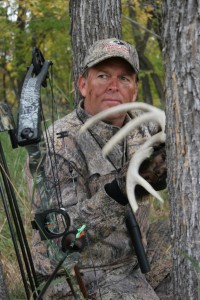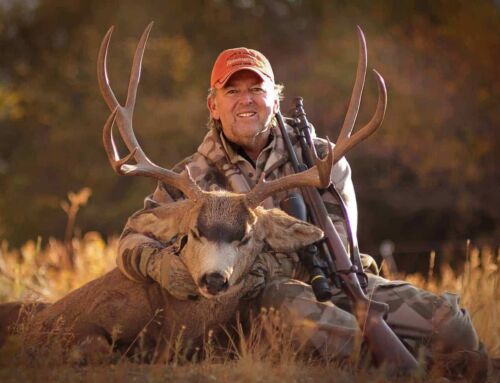 Dr. Mick Hellickson, one of the top deer scientists in America, conducted a three-year project on whitetail behavior and antler rattling on a 10,000 ranch in South Texas. The deer population was healthy and the buck:doe ratio was near 1:1. His researchers rattled in two-man teams during all three phases of the rut each November and December. When a buck came in, they noted the time, weather, etc., and videotaped each deer so later they could estimate its age and rack score.
Dr. Mick Hellickson, one of the top deer scientists in America, conducted a three-year project on whitetail behavior and antler rattling on a 10,000 ranch in South Texas. The deer population was healthy and the buck:doe ratio was near 1:1. His researchers rattled in two-man teams during all three phases of the rut each November and December. When a buck came in, they noted the time, weather, etc., and videotaped each deer so later they could estimate its age and rack score.
I mention that Mick’s research was conducted more than a decade ago, which has been a good thing for me. It has allowed me to compare and analyze the study’s key points against my field notes and observations as I’ve hunted and rattled across America these last years. Read on and you will see that my real-world hunting pretty much jibes with Mick’s findings, with minor variations here and there.
When to Rattle: Over the three-year period, the researchers rattled 171 times at different locations and pulled in 111 bucks. A response rate of 65 percent is impressive, but the best info is found inside the numbers.
Mick says, “The peak of the rut is by far the best time to rattle in the most bucks, the most numbers.” During the wild days, when frenzied bucks troll and/or chase, 65 bucks responded to 60 rattling sequences—a 108 percent response rate. Sometimes two or three bucks charged or circled into their rattles. On two occasions, eight different bucks responded.
While you might certainly rattle in a big deer that is feeling his oats and rutting early, say around October 20, I believe your chances are much better if you wait to rattle until November 1, and then keep it up until just before Thanksgiving. This way you don’t burn out your best spots and stands before most testosterone-addled bucks get in the mood to hear your fights and come in.
For years I have shouted to anyone who would listen that the first 10 days the post-rut (late November into early December in most areas) are one of the best times to rattle up a big buck. The post-rut is when Hellickson’s crew rattled up the most mature animals. Of the 29 bucks that responded to 51 rattling sequences during this phase, 10 were 5½ years old, and another 10 were 3 ½ to 4 ½. Easy lesson: Don’t give up on your rattling too soon!
Time to Rattle: You’ll have your best luck in the mornings. This has played out so many times for me in recent years that I rarely carry my horns in the afternoon anymore. And the science confirms it. Sixty of 111 bucks (67 percent) that the researchers banged in came to the horns between 7:30 and 10:30 a.m. Cool days with 75 percent cloud cover and little or low wind speed were best.
How to Rattle: “If you aren’t exhausted after a sequence, you didn’t rattle hard enough,” said Hellickson. He and his crew rattled aggressively 85 times and attracted 81 bucks. Their 86 shorter, quieter sequences pulled in only 30. The length of a rattling session didn’t matter much. Both one- and three-minute volleys lured an equal number of bucks.
This jibes with my hunting, because I rarely spar the horns or rattle lightly anymore. I used to, but horn sparring and tinkling never seemed to work for me. Besides, the fun of it is to go out in the rut, bang and grind the heck out of the horns, bust and rake some brush, and then wait quietly in anticipation of what might happen.
Expectations: As compared to the Texas ranch where Mick did his work, the private or public ground you and I hunt will hold fewer mature bucks, and likely the buck:doe ratio won’t be so good. Still, use the research as a guide to rattle on. Climb into a tree stand or sit hidden on a ridge on a cool, still morning from early November on, and keep trying it through the first week of December. Don’t rattle every day, just select days when the weather is right and the bucks are rutting. Whack the horns, lay them down, keep still and scan the woods. Oh yeah, have your bow or gun ready, a big buck might just be coming.
Rattle Setup Tips: An hour or after sunrise, move toward thick-cover areas where you know or think bucks hide out and rattle…. Always approach and set up from downwind before you crack the horns…. Set up on a downwind edge of cover where you are hidden, but where you can see well…. Sit on a low ridge, bank or similar vantage (but don’t skyline); during the Texas rattling study, researchers in towers saw every buck that came to the horns, while rattlers on flat ground were lucky to see half the bucks. Get elevated…. Sit with the rising sun and good cover behind you…. Make sure you can see reasonably well to either side downwind, as many bucks circle with the wind to try and sniff out the fighters. Carry a wind-checker and test the breeze often. If it starts to swirl and turn bad as the sun heats up the ground—very common–back out and move to a better setup.
Best Rattling Horns: I’ve tried a variety of real and synthetic horns, and most of the rattle bags and gadgets. Any one of them will work if you catch a rutting buck in the right mood to respond. But I like the real antlers of a 130- to 140-class buck, which to me have just the right mass and heft to feel good and sound good. Saw off the brow tines and wear leather gloves to keep from mashing fingers.






Good post Mike. If I could only bring one call into the woods it would be my rattling antlers. Have had great luck with them over the years. Totally agree, mornings are definitely the best. Cant even remember if I ever rattled one in the afternoon . Like Dean I like to throw a snort wheez in there too.
Good timing Hanback. I “sight rattled” (see him first, then try to get him in for shot) a bruiser buck on Tues. evening. With snort-wheezes (my own “voice”), a bit of the Can, and the horns I got him into about 50 yards and then ran out of legal light. Still, it was worth the efforts and came close to working. I’ll add that in places where there is more pressure it’s best not to overdo the calling. If you have his attention, stop. If he hangs up throw in a snort-wheeze and see what you can do. I have rattled here in my home area and scared the be-jesus out of bucks. I’m convinced that if they hear it enough and don’t associate it with real deer they can file that away. Rattling isn’t guaranteed in areas with moderate to high pressure; but it can work during archery. Throw in scents/urines and/or decoys and this can seal the deal.